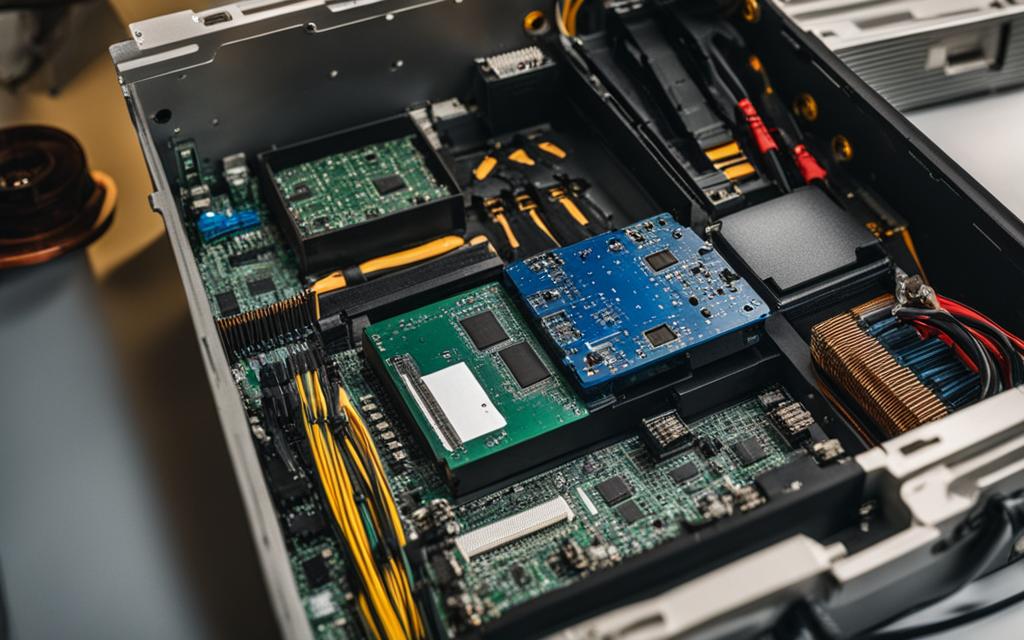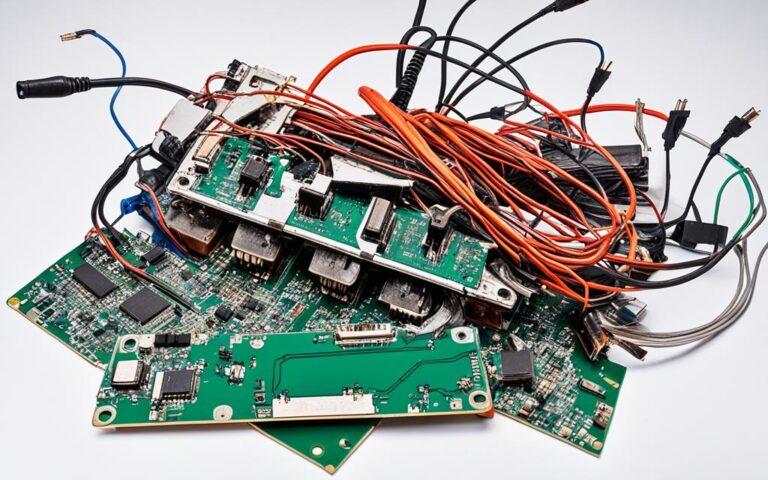Recovering Data from RAID Arrays: A Technical Overview
Welcome to our comprehensive guide on RAID array data recovery. In this article, we will provide a step-by-step technical overview of the process involved in recovering data from failed RAID drives. Whether you have experienced a hardware failure, software glitch, or human error, understanding the RAID recovery process is crucial to retrieve your valuable data.
Before we dive into the details, let’s briefly explain what RAID stands for. RAID, short for Redundant Array of Independent Disks, is a storage technology that combines multiple physical drives into one logical unit. This configuration offers increased performance, fault tolerance, and data redundancy.
However, RAID arrays are not immune to failures. Whether it’s a drive crash, controller malfunction, or RAID configuration issue, these failures can result in data loss. That’s where RAID data recovery comes into play. It involves specialized techniques and tools to extract and restore data from faulty RAID arrays.
In the following sections, we will explain the step-by-step process of RAID data recovery, including the different RAID levels and common failures. We will also discuss the importance of case evaluation and the factors that influence the cost of recovery. Lastly, we will highlight the services offered by Proven Data, a trusted RAID recovery company.
If you’re facing a RAID data loss situation, stay tuned and let us guide you through the intricate world of RAID recovery. Understanding the technical aspects of this process will help you make informed decisions and increase the chances of successful data retrieval.
What is RAID Data Recovery and How Does it Work?
RAID data recovery is the process used by recovery engineers to restore data from failed RAID drives. It involves several steps, including making a copy of all drives, running diagnostics on each drive, analyzing the metadata, reproducing the physical RAID, using the filesystem to locate data, extracting and testing sample files, and finally, extracting all available data from the RAID array.
The recovery process varies depending on the RAID level and the severity of the failure. RAID drives can fail due to various reasons, including hardware or software failures, human errors, power surges, and more.
Step-by-Step RAID Data Recovery Process
- Make a copy of all drives: This step ensures that the original data remains untouched during the recovery process.
- Run diagnostics on each drive: Diagnostic tools are used to identify any faulty drives and determine the extent of the damage.
- Analyze the metadata: The recovery engineers examine the RAID metadata to understand the configuration and layout of the array.
- Reproduce the physical RAID: Using the gathered information, the engineers recreate the RAID structure to access the data stored within.
- Use the filesystem to locate data: The engineers rely on the filesystem to locate and identify the desired files and directories within the RAID array.
- Extract and test sample files: Sample files are extracted and tested to ensure the integrity of the recovered data.
- Extract all available data: Finally, all available data is extracted from the RAID array and prepared for retrieval.
The step-by-step process ensures that the recovery engineers follow a systematic approach to retrieve data from the failed RAID drives. By understanding the RAID levels and the specific failures, they can employ the appropriate techniques and tools to maximize the chances of successful data recovery.
RAID Levels
RAID (Redundant Array of Independent Disks) arrays come in different levels, each offering varying degrees of fault tolerance and performance. The common RAID levels include:
- RAID 0: Offers high performance and data striping across multiple drives, but no fault tolerance.
- RAID 1: Provides data mirroring for enhanced data redundancy and fault tolerance.
- RAID 5: Combines block-level striping with distributed parity for improved performance and fault tolerance.
- RAID 6: Similar to RAID 5 but with dual distributed parity, offering higher fault tolerance for even greater data protection.
Understanding the specific RAID level of the failed array is crucial for the recovery process, as it impacts the techniques and tools used by the recovery engineers.
Common RAID Failures
RAID drives can fail due to various reasons, including:
- Hardware failures: Such as problems with the hard drives, controllers, or connectors.
- Software failures: Including issues with the RAID management software or operating system.
- Human errors: Mistakes made during the RAID configuration, management, or maintenance.
- Power surges: Sudden voltage spikes that can damage RAID components.
- Natural disasters: Events like floods, fires, or earthquakes that can physically damage the RAID array.
Identifying the cause of the RAID failure is essential for selecting the appropriate data recovery techniques and determining the chances of successful recovery.
| RAID Level | Fault Tolerance | Performance |
|---|---|---|
| RAID 0 | No fault tolerance | High performance |
| RAID 1 | Full data mirroring | Lower performance |
| RAID 5 | Single distributed parity | Balanced performance and fault tolerance |
| RAID 6 | Dual distributed parity | High fault tolerance |
The table above summarizes the different RAID levels, their associated fault tolerance, and performance characteristics.
Starting the RAID Recovery Process
The first step in the RAID recovery process is to initiate a case evaluation with a reputable data recovery company. To begin the process, fill out a ticket providing basic information about the case. The data recovery service will then provide instructions on the next steps to follow. It is crucial to discontinue using the failing device immediately to prevent further damage and increase the chances of successful data recovery.
During the case evaluation, the data recovery engineers will ask several questions related to the data loss scenario. Providing detailed information about what happened and when it occurred will aid in accurately assessing the failure and determining the appropriate recovery techniques. In addition, the following details will be requested:
- Number of hard drives in the RAID configuration
- Type of file system used
- Total storage capacity of each drive
- Manufacturer of the server
- RAID configuration details
- Hard drive interface
- Any previous recovery attempts
These specific details about your RAID setup and the data loss scenario will allow the experts to tailor the recovery process to your unique situation. It is essential to provide accurate information to ensure an effective and efficient data recovery process.
Once the case evaluation is complete and all necessary information has been obtained, the data recovery service will provide an estimated cost and timeframe for the RAID recovery process. This information will help you make an informed decision regarding the next steps to take in the data recovery journey.
Step-by-Step RAID Recovery Process
The RAID recovery process involves several critical steps that enable the successful retrieval of data from a failed RAID array. Each step is carefully executed to ensure the highest chances of data recovery and minimize the risk of further damage. Let’s take a closer look at the step-by-step RAID recovery process:
Making a Copy of All Drives
The first step in RAID recovery is creating an identical copy of all drives in the array. This copy serves as a safeguard to prevent any further data loss during the recovery process. It is crucial to ensure that the copy is an exact replica of the original drives.
Diagnostics and Repairs
Next, the recovery process involves running diagnostics on each drive. This step helps identify any broken drives and enables the necessary repairs to be made. Data recovery experts utilize advanced diagnostic tools and techniques to assess the health and status of each drive.
Metadata Analysis
The metadata on each RAID drive is analyzed to gain a deep understanding of the drive’s size, type, order, and recent data. This analysis helps in reconstructing the data structure and identifying the logical units of the RAID array.
Physical RAID Reproduction
Reproducing the physical RAID is a crucial step in the recovery process. This involves rebuilding the RAID array to recover the data tree and establish the logical connections between the drives. The successful reproduction of the physical RAID ensures the accessibility of the data.
Filesystem Analysis
After reproducing the RAID, the next step is to analyze the filesystem. The filesystem provides critical information about the location and structure of the data on the array. This analysis helps locate the desired data and extract it during the recovery process.
Data Extraction and Sample Files
Once the filesystem is analyzed, data extraction is performed to retrieve all available data from the RAID array. A comprehensive extraction is conducted, ensuring that no valuable information is left behind. Additionally, sample files are extracted for testing purposes to verify the success of the recovery process.
Verification and Data Retrieval
Verification is an essential step to ensure the integrity of the recovered data. The sample files extracted earlier are used to test and confirm the successful retrieval of the data. If the recovery is verified, a detailed list of the recovered files is provided to the client, and the data is transferred to a healthy drive for retrieval.
The step-by-step RAID recovery process involves a combination of technical expertise, advanced tools, and meticulous execution. The data recovery experts at Proven Data utilize their extensive knowledge and experience to ensure a successful and secure RAID recovery.
Cost of RAID Recovery
The cost of RAID recovery can vary depending on several factors that influence the overall expenses. These factors include the severity and type of failure, the number of hard drives in the RAID array, and the amount of data to be recovered.
When dealing with RAID recovery, it is crucial to consider the complexity of the RAID configuration and the extent of the damage. These aspects can significantly impact the time required to complete the recovery process.
Proven Data, a leading provider of RAID recovery services, offers 24/7 support and expertise to ensure the successful retrieval and return of RAID data. Their team of experienced RAID recovery engineers can provide an estimated cost based on the information provided during the initial case evaluation.
The cost may vary depending on the evaluation type chosen, such as standard evaluation or emergency evaluation. This allows clients to select the most suitable option based on their specific needs and urgency.
For a detailed breakdown of the factors that affect RAID recovery cost and a personalized estimate, it is recommended to reach out to Proven Data’s professional team.
Factors Affecting RAID Recovery Cost:
- Severity and type of failure
- Number of hard drives in the RAID array
- Amount of data to be recovered
Factors Affecting RAID Recovery Time:
- Complexity of the RAID configuration
- Extent of the damage
With Proven Data’s expertise and comprehensive support, clients can rest assured that their RAID recovery needs will be handled with utmost care and efficiency.
Performing RAID Data Recovery without Backup
In the unfortunate event of data loss without a backup, it is still possible to recover your RAID data using advanced software tools like Stellar Data Recovery Technician. This powerful software is designed specifically to rebuild broken or corrupt RAID arrays and retrieve lost or deleted data. Whether you have a RAID 0, RAID 5, or RAID 6 array, Stellar Data Recovery Technician provides the necessary tools and features to facilitate a successful recovery process.
The steps involved in performing RAID data recovery without a backup are as follows:
- Disconnect the RAID drives from the array.
- Connect the RAID drives to a Windows PC.
- Install and run Stellar Data Recovery Technician software on the Windows PC.
- Select the RAID volume from which you want to recover data.
- Initiate the scanning process to identify and analyze the data in the RAID volume.
- Preview the recovered files and select the ones you want to recover.
- Choose a safe location to save the recovered data.
- Create a backup copy of the recovered data and store it in a secure location.
- Rebuild the RAID array from scratch to ensure the safety of your data.
The use of Stellar Data Recovery Technician provides a user-friendly interface that simplifies the otherwise complex process of RAID data recovery without a backup. By following these steps, you can increase the chances of successfully reconstructing your RAID array and retrieving all essential data.
“With Stellar Data Recovery Technician, the recovery of your RAID data becomes a streamlined process, allowing you to regain access to your valuable files and documents. Its powerful features and intuitive interface make it an excellent choice for individuals and businesses seeking effective RAID data recovery solutions.”
While Stellar Data Recovery Technician is capable of recovering data from various RAID configurations, it is crucial to remember that in cases of data loss, prevention is always better than cure. Regular backups of your RAID data should be a priority to avoid the potential risks associated with data loss.
Conclusion
RAID data recovery is a complex process that requires the expertise of recovery engineers and the use of specialized software tools. It is crucial for businesses and individuals to have a backup of their RAID data to prevent permanent data loss. However, in the unfortunate event of data loss, there are professional services available, such as Proven Data, that offer comprehensive RAID recovery support.
The RAID recovery process involves multiple steps that are executed meticulously to maximize the chances of successful data retrieval. These steps include creating a copy of the drives, running diagnostics to identify any issues, analyzing the metadata to understand the RAID configuration, and reproducing the physical RAID to rebuild the data structure. Through the use of filesystem analysis, the recovery engineers locate and extract all available data from the RAID array.
The cost of RAID recovery varies based on factors such as the complexity of the failure, the RAID level, and the amount of data to be recovered. Proven Data provides professional support and expertise in RAID data recovery, offering tailored solutions and comprehensive evaluation to determine the best course of action for each case. In situations where a backup is not available, software tools like Stellar Data Recovery Technician can be effective in recovering data from broken or corrupt RAID arrays.
It is vital to emphasize that in the absence of a backup, rebuilding the RAID array and creating a backup of the recovered data is essential to ensure data safety. RAID data recovery is a meticulous process that should be entrusted to experienced professionals to maximize the chances of successful recovery and minimize the risk of further data loss.












